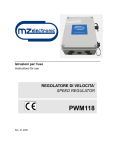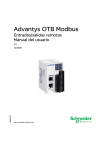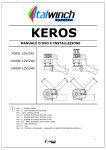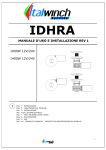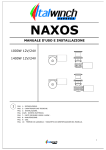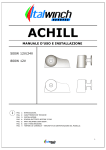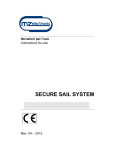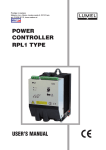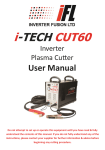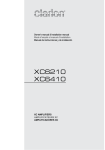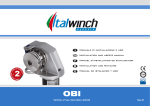Download regolatore di velocita` rpwm
Transcript
Istruzioni per l’uso Instructions for use REGOLATORE DI VELOCITA’ SPEED REGULATOR RPWM Rev. 04 – 2008 Italiano REGOLATORE DI VELOCITA’ RPWM Il regolatore di velocità è ideale per variare la velocità di movimento di salpa ancora o verricelli di tonneggio o per limitare l’elevata corrente di spunto dei motori Bow Thruster e permettere così di avere una variazione dolce e progressiva e maggiore manovrabilità in fase di attracco e movimentazione in porto. ELENCO COMPONENTI n. 1 Pulsantiera PWM. Cavo estensibile a 3,5 mt. n. 1 presa 6 poli IP 68 fissata all’apparecchio. n. 1 cappuccio per copertura presa a spina estratta. n. 3 Cappucci plastica per dadi M8, e 1 per dado M6. n. 1 regolatore PWM in contenitore di alluminio anodizzato. n. 1 istruzioni per il montaggio. DIMENSIONI Dimensioni centralina: Dimensioni pulsantiera: 230 x 185 x 90 mm. 140 x 60 x 20 mm. CARATTERISTICHE TECNICHE Alimentazione 10 a 28V con commutazione automatica. Frequenza di lavoro 490 Hz Corrente massima erogabile: CONTINUA 235 A a 12V o 24V Corrente di punta: max 320 A a 12V o 24V Regolazione velocità: continua da 6% a 100% Per motori a 2, 3 e 4 fili. Ventilazione forzata del dissipatore PWM Invertitore di marcia integrato Protezione contro l’inversione di polarità applicata. Chiusura e apertura dei contatti relè di potenza a corrente zero. Rampa di accelerazione regolabile da 0,8 a 3 secondi . Controllo incollaggio relè di potenza e unità statica con segnalazione Led. Segnalazione Led di intervento MAX temperatura con limitazione della velocità al 50%. Segnalazione istantanea a Led di intervento MAX corrente, con arresto motore per sovraccarico. Ripristino automatico dopo 5 sec. Controllo efficienza unità di potenza con segnalazione guasto. RPWM -2- REV. 4-2008 Italiano Protezione software di sovracorrente con soglia impostabile tramite un quadruplo dipswitch, SW1 in funzione della seguente tabella 1 (valori nominali) IMPOSTAZIONE MASSIMA CORRENTE MOTORE NOTA: Il valore della soglia di corrente per la protezione software può subire variazioni tipiche del 10% rispetto al valore nominale. La protezione software interviene dopo un tempo che dipende dalla percentuale di sovraccarico secondo la seguente tabella 2: RPWM -3- REV. 4-2008 Italiano TABELLA2 CORRENTE NEL MOTORE TEMPO DI INTERVENTO 100%> I <120% 3.2 SEC 120%> I <140% 1.6 SEC 140%> I < I MAX 1 SEC > IMAX = 320A 60 ms Nel caso di intervento software per sovraccarico quando la corrente torna a valori normali il ripristino è automatico dopo 5 secondi • Protezione hardware di sovracorrente si imposta automaticamente a 320 Amp • La protezione interviene istantaneamente al superamento della soglia. Nel caso di intervento hardware per sovraccarico quando la corrente torna a valori normali il ripristino è automatico dopo 5 secondi al rilascio dei comandi. INSTALLAZIONE STACCARE SEMPRE LA BATTERIA PRIMA DI PROCEDERE ALL’INSTALLAZIONE! 1) Montare il box su una parete verticale con il ventilatore nella parte inferiore. 2) Collegare un cavo di adeguata sezione, in funzione della potenza motore, dal POSITIVO Batteria al morsetto + del control box interponendo una protezione elettrica (fusibile) o un interruttore automatico ed un cavo dal NEGATIVO Batteria al morsetto M6 NEG. sulla scheda del regolatore. 3) MOTORE A 2 FILI: Collegare i due fili del motore ai morsetti M1 e M2 del control box 4) MOTORE A 3 FILI: Collegare i due fili rot. dx e rot. sx a M1 e M2 del control box e il terzo filo al morsetto C2 sul dissipatore 5) MOTORE A 4 FILI: Collegare i due fili rot. dx e rot. sx al contatto M3 del control box e al contatto C2 sul dissipatore e collegare i due fili dell’avvolgimento di campo sui contatti M1 e M2 del controlbox 6) Coprire i morsetti di potenza con i cappucci di plastica neri di corredo 7) Inserire il connettore della pulsantiera nella presa e avvitare la ghiera di serraggio. REGOLAZIONE DELLA VELOCITA’ DEL MOTORE • Regolazione continua da 6% a 100% con potenziometro esterno. • Rampa di accelerazione regolabile da 0,8 a 3sec. massimo. La durata della rampa è impostabile attraverso il trimmer RV2 sulla scheda. • Ruotando RV2 in senso orario DIMNUISCE la rampa di accelerazione. RPWM -4- REV. 4-2008 Italiano • Limitazione della velocità del motore al 50% nel caso di superamento della soglia di temperatura di 70°C sul dissipatore interno. Quando la temperatura torna sotto i 60°C la velocità viene riportata al 100%. COMANDI PULSANTIERA Tasto ON accensione con led di ON Tasti AUM e DIM per l’impostazione della velocità Tasti LEFT e RIGHT per il senso di rotazione del motore Bar led velocità impostata dal 20% a 100% con 8 led Auto OFF dopo 2 minuti dall’ultimo comando dato Descrizione funzionamento: All’accensione,premendo il tasto ON si accende il led ON ed il primo led a sinistra della velocità minima. Premendo AUM si incrementa il valore di set della velocità, i led velocità si accendono gradualmente da sinistra a destra. Premendo DIM si diminuisce il valore di set della velocità, i led velocità si spengono gradualmente da destra a sinistra. In questa fase di set velocità vengono ignorati eventuali comandi LEFT o RIGHT. Premendo LEFT si attiva il comando rotazione motore sinistra. Il motore si porta gradualmente alla velocità impostata in funzione del valore della rampa di accelerazione impostato sul regolatore. Mantenendo LEFT premuto e premendo i tasti AUM o DIM è possibile variare la velocità. I led si accendono o spengono di conseguenza. Al rilascio di LEFT il motore si arresta istantaneamente, i led velocità restano accesi al valore precedentemente impostato. Premendo il tasto RIGHT si inverte la rotazione motore, le altre funzioni come sopra. Dopo 2 minuti dall’ultimo comando dato la pulsantiera si spegne, 10 sec. prima di spegnersi il led ON diventa intermittente, poi si spegne assieme ai led velocità. Al successivo comando ON, i led della velocità si accendono al valore precedentemente impostato. Se viene estratta la spina non viene mantenuto il set della velocità. Al reinserimento la condizione è la stessa che si ha all’accensione. RPWM -5- REV. 4-2008 Italiano SEGNALAZIONI A LED DISPONIBILI: LED LINE ON LED OVERLOAD LED INC RELE’ LED MAX TEMP LED CCMOS LED PWM SULLA SCHEDA SONO PRESENTI 6 LED INDICATI NELLA FIGURA SEGUENTE: DESCRIZIONE SEGNALAZIONI: • LED PWM: DI COLORE GIALLO SI ACCENDE COME SOPRA E INDICA IL CONTROLLO DEL PWM DEL MOTORE ATTIVO • LED CCMOS: DI COLORE ROSSO SI ACCENDE PER UN GUASTO DELL’UNITÀ DI POTENZA MOSFET. • LED MAX TEMP: COLORE ROSSO SI ACCENDE PER TEMPERATURE DEI MOSFET SUPERIORI A 70°C ED IN QUESTO CASO LA VELOCITÀ DEL MOTORE VIENE LIMITATA AL 50% SI SPEGNE QUANDO LA TEMPERATURA SCENDE AL DI SOTTO DEI 60°C. • LED INC RELE’: DI COLORE ROSSO INDICA LA PRESENZA DI ANOMALIE NEL FUNZIONAMENTO DELL’INVERTITORE DI MARCIA. • LED OVERLOAD: DI COLORE ROSSO INDICA IL SUPERAMENTO DELLA SOGLIA DI MASSIMA CORRENTE IMPOSTATA DAI DIP-SWITCH. L’INTERVENTO È GESTITO COME DA TABELLA 2 • LED LINE ON: DI COLORE VERDE INDICA LA CORRETTA ALIMENTAZIONE ALL’APPARECCHIO. SEGNALAZIONI AGGIUNTIVE A SEGUITO DI: INTERVENTO MAX CORRENTE ISTANTANEA, si accende intermittente per 6 sec. il led OVERLOAD. Se un pulsante di comando viene tenuto premuto il led continua a lampeggiare, il ripristino è automatico al rilascio del pulsante. PULSANTI PREMUTI AL POWER ON, si accende intermittente led giallo PWM. RPWM -6- REV. 4-2008 Italiano Il regolatore è in blocco, per ripristinare il funzionamento occorre rilasciare il pulsante. TIME OUT FUNZIONAMENTO, se il motore funziona continuamente per piu di 10 minuti il regolatore si blocca, lampeggiano i 4 led rossi. Per il ripristino occorre spegnere e riaccendere l’apparecchio. RPWM -7- REV. 4-2008 English SPEED REGULATORS Speed regulators are ideal for adjusting anchor winch or warping winch speed or for limiting the elevated pick-up current of bow thruster motors so as to achieve smooth, gradual variations and better manoeuvrability during docking and other movements inside the harbour. LIST OF COMPONENTS 1 PWM control panel. Cord extendible to 3.5 m. 1 6-pole socket IP 68 fixed to the device. 1 cap for covering the socket when plug is removed. 3 plastic caps for M8 nuts and 1 for M6 nut. 1 PWM regulator in an anodised aluminium enclosure. 1 set of installation instructions. DIMENSIONS Controller dimensions: 230 x 185 x 90 mm. Control panel dimensions: 140 x 60 x 20 mm. TECHNICAL DATA Power supply 10 to 28V with automatic changeover. Operating frequency 490 Hz Max output current: CONTINUOUS 235 A at 12 or 24V Inrush current: max 320 A at 12 or 24V Speed adjustment: continuous from 6% to 100% For 2, 3 and 4 wire motors. Forced ventilation of the PWM heatsinker Integrated rotation inverter unit Reverse polarity protection. Opening and closing of power relay contacts at zero current. Acceleration ramp adjustable from 0.8 to 3 seconds. Monitoring of power relay locking and static unit with LED warning. LED overtemperature warning with limitation of speed to 50%. Instantaneous LED overcurrent warning with motor shutdown after 3 sec. of overload. Automatic re-enabling of operation after 5 sec. Monitoring of power unit efficiency with fault warnings. Software overcurrent protection with threshold settable by means of a quadruple DIP switch, SW1 as indicated in table 1 below (rated values) RPWM -8- REV. 4-2008 English SETTING OF MAXIMUM MOTOR CURRENT NOTE: The software protection current threshold value is subject to typical variations of +/-10% in relation to the rated value. The software protection will trip after a given amount of time depending on the overload percentage, as indicated in table 2 below. TABLE 2 CURRENT IN THE MOTOR 100%> I <120% 120%> I <140% RPWM TRIP TIME 3.2 SEC 1.6 SEC -9- REV. 4-2008 English 140%> I < I MAX > I MAX 320A 1 SEC 60 ms If an overload causes the software protection to trip, when the current returns to normal values operation will be automatically re-enabled after 5 seconds • The hardware overcurrent protection is automatically set at 320 Amp • The protection will trip instantly when the current exceeds the threshold. If an overload causes the hardware protection to trip, when the current returns to normal values operation will be automatically re-enabled after 5 seconds, once the controls are released. INSTALLATION ALWAYS DISCONNECT THE BATTERY PRIOR TO INSTALLATION! 1) Mount the box on a vertical wall with the fan side down. 2) Connect an adequately sized wire, depending on the motor power, from the POSITIVE pole of the battery to the + terminal of the control box, interposing an electrical protection (fuse) or automatic breaker, and another from the NEGATIVE pole of the battery to the M6 NEG. terminal on the regulator circuit board. 3) 2-WIRES MOTOR: connect the wires of the motor to M1 and M2 contacts of the control box 4) 3-WIRES MOTOR: connect the wires “rot. Dx” and “rot. Sx” to M1 and M2 contacts of the control box and the third wire to C2 contact on the heatsinker 5) 4-WIRES MOTOR: connect the wires “rot. Dx” and “rot. Sx” to M3 contact of the control box and to C2 contact on the heatsinker. Connect the wires from the field winding to M1 and M2 contacts of the control box 6) Cover the power terminals with the black plastic caps provided 7) Insert the control panel connector in the socket and tighten the locknut. REGULATION OF MOTOR SPEED • Continuous adjustment from 6% to 100% with external potentiometer. • Acceleration ramp adjustable from 0.8 to a maximum of 3 sec. The duration of the ramp can be set by means of trimmer RV2 on the circuit board. • Turning RV2 clockwise will DECREASE the acceleration ramp. • Motor speed limited to 50% if the temperature threshold of 70°C is exceeded on the internal heat sink. When the temperature again falls below 60°C the speed will be brought back to 100%. RPWM - 10 - REV. 4-2008 English PWM PUSH BUTTON PANEL • • • • • ON button provided with ON led AUM and DIM buttons in order to set speed. LEFT and RIGHT keys for motor rotation direction speed bar let set from 20% to 100% provided with 8 leds Auto OFF after 2 minutes since the last command is given Functioning: In order to power on press the ON button, the ON led and the first led on the left side of the minimum speed turn on. Pressing AUM you increase the speed set value, the speed leds gradually turn on from left to right. Pressing DIM you decrease the speed set value, the speed leds turn off from right to left by degrees. During this speed regulation phase the LEFT and RIGHT controls are ignored, if they are employed. Pressing LEFT you activate the left motor rotation control. The motor sets by degrees to the speed which has been set, accordingly to the acceleration ramp which has been set on the regulator. Keeping the left button pressed and pressing meantime AUM or DIM it is possible to change the speed. The leds turn on and off consequently. Releasing the LEFT button the motor stops instantaneously; the speed leds remain turned on, according to the value which has been set before. Pressing the RIGHT button you reverse the motor rotation, the other functions remain just the same as above described. After 2 minutes since the last command has been given the control reaches a OFF status, 10 seconds before turning off, the ON led blinks intermittently, then it turns off meantime with the speed leds. Once activating ON again, the speed leds turn on to the value that has been set before. If you pull out the plug the speed set is not memorized. When you plug in, you will meet the same conditions as on POWER ON. RPWM - 11 - REV. 4-2008 English AVAILABLE LED INDICATIONS AND WARNINGS: LINE ON LED OVERLOAD LED RELAY LOCK LED MAX TEMP LED CCMOS LED PWM LED ON THE CIRCUIT BOARD THERE ARE 6 LEDS, ILLUSTRATED IN THE FIGURE BELOW. DESCRIPTION OF INDICATIONS AND WARNINGS: • PWM LED: YELLOW. IT LIGHTS UP AS ILLUSTRATED ABOVE AND INDICATES THAT THE PWM MOTOR CONTROLLER IS ON • CCMOS LED: RED. IT LIGHTS UP TO WARN OF A MOSFET POWER UNIT FAULT. • MAX TEMP LED: RED. IT LIGHTS UP WHEN THE MOFSET TEMPERATURE RISES ABOVE 70°C AND IN THIS CASE THE MOTOR SPEED IS LIMITED TO 50%. IT GOES OFF WHEN THE TEMPERATURE FALLS BELOW 60°C. • RELAY LOCK LED: RED. IT WARNS OF FAULTS IN STARTING INVERTER OPERATION. • OVERLOAD LED: RED. IT WARNS OF CURRENT VALUES EXCEEDING THE THRESHOLD SET BY THE DIP SWITCHES. TRIPPING OCCURS AS INDICATED IN TABLE 2 • LINE ON LED: GREEN. IT INDICATES THAT THE UNIT IS CORRECTLY POWERED. ADDITIONAL WARNINGS GIVEN FOLLOWING: TRIPPING OF INSTANTANEOUS OVERCURRENT PROTECTION, the OVERLOAD LED lights up and blinks intermittently for 6 sec.. If a control button is kept pressed down the LED will continue to blink; operation will automatically be re-enabled upon release of the button. BUTTONS PRESSED DOWN WHEN POWER SWITCHED ON, the yellow PWM blinks intermittently. The regulator is disabled, to resume operation release the button. OPERATING TIMEOUT, if the motor runs non-stop for more than 10 minutes the regulator will be disabled. The 4 red LEDs will start flashing. To re-enable the regulator, switch it off and back on again. RPWM - 12 - REV. 4-2008 Note / Notes MZ ELECTRONIC S.R.L. www.mzelectronic.com e-mail:[email protected]




















